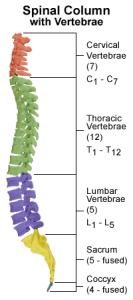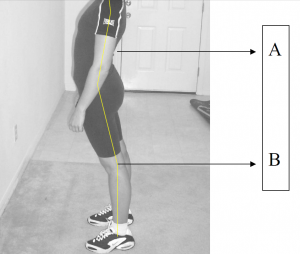Abnormal Curvature of the Back (Scoliosis, Lordosis and Kyphosis)
Today were going to talk about three conditions of the spine known as scoliosis, lordosis and kyphosis. Each of these conditions relates to an abnormal curvature of the spine. Let’s take a look at what each of them are and who is at risk for them.
Spine Anatomy…with a Twist

If you’re a loyal reader to the Saratoga Spine blog you might remember our series on the anatomy of the spine. In that series we explained the normal curvature of the spine. Just in case you don’t remember, we’ll refresh your memory.
If a person is standing directly in front of you and you are looking squarely at their back their spine should be straight up and down. Now let’s suppose that same person turned so you could see their profile. If you had x-ray vision you’d see that their spine is not straight, it has three curves.
In the cervical, or neck, region the spine curves toward the front of the body. As you travel down the spine into the thoracic region (the upper back) the spine starts to curve toward the back of the body. Finally, continuing down to the lower back or lumbar region, the backbone curves toward the front of the body again.
Abnormal Curvature of the Back
Any variation from the normal curvature of the back can lead to problems. The conditions associated with an abnormal curvature of the back are scoliosis, lordosis, and kyphosis. Let’s take a closer look at what each of these conditions are and how they differ.
Scoliosis
Scoliosis is probably the most well known condition of the three. You may even remember going to the nurses office in primary school to get checked for scoliosis. That’s because scoliosis often develops in children or young teenagers (although babies can be born with it).
Scoliosis is a sideways curvature of the spine. If an individual with scoliosis is standing directly in front of you and you are looking squarely at the back, their spine would not be straight up and down. In other words, the spine would curve toward the left and/or right side of their body. This curvature is a result of shifts in the vertebrae and/or rotation of the vertebrae which causes a sideways curve. The number and size of the curves can vary in scoliosis patients.
Scoliosis patients are commonly fitted with a back brace. This brace is specially designed to straighten out their spine. Oftentimes the back brace is enough to bring the spine back in to correct position and surgery is not required.
Lordosis (Hyperlordosis)

Lordosis
By CarpalTunnelEx, via Wikimedia Commons
The curvature of the cervical and lumbar regions of the spine toward the front of the body are called lordosis. When the curve of the lower back is excessive, the condition is known as hyperlordosis or sometimes simply referred to as lordosis. (This condition can also be referred to as lumbar hyperlordosis, swayback, hollow back or saddle back.)
Lumbar hyperlordosis can develop as a result of the individual’s posture and lifestyle. As an example, dancers are more prone to developing hyperlordosis than non-dancers. Medical conditions us such as vitamin deficiencies, spondylolisthesis, or osteoporosis can also lead to hyperlordosis as a result of shifting vertebrae.
Similar to scoliosis, lumbar hyperlordosis is most commonly treated without surgery. With the use of mechanical bracing, exercises and lifestyle changes in individuals hyperlordosis can be corrected.
Kyphosis (Hyperkyphosis)
Just as the cervical and lumbar curves of the spine are referred to by a name, so is the thoracic curve. The backward curvature of your upper back is called kyphosis or the kyphotic curve. When the backward curvature of your upper spine is exaggerated it’s a condition known as hyperkyphosis. (It is also commonly referred to as roundback or hunchback.) You may recognize this condition from the famous story, The Hunchback of Notre Dame. This abnormal curvature of the spine is often visible and can cause an individual to look as if they are hunched forward, hence the term hunchback.
Hyperkyphosis can occur at any age but is common in adolescents as their bones develop. Hunchback can occur as a result of poor posture, growth abnormalities, or congenital defects. The condition can be treated non-surgically for most patients. Similar to hyperlordosis and scoliosis, treatments include physical bracing, changes in posture and physical therapy.
References
